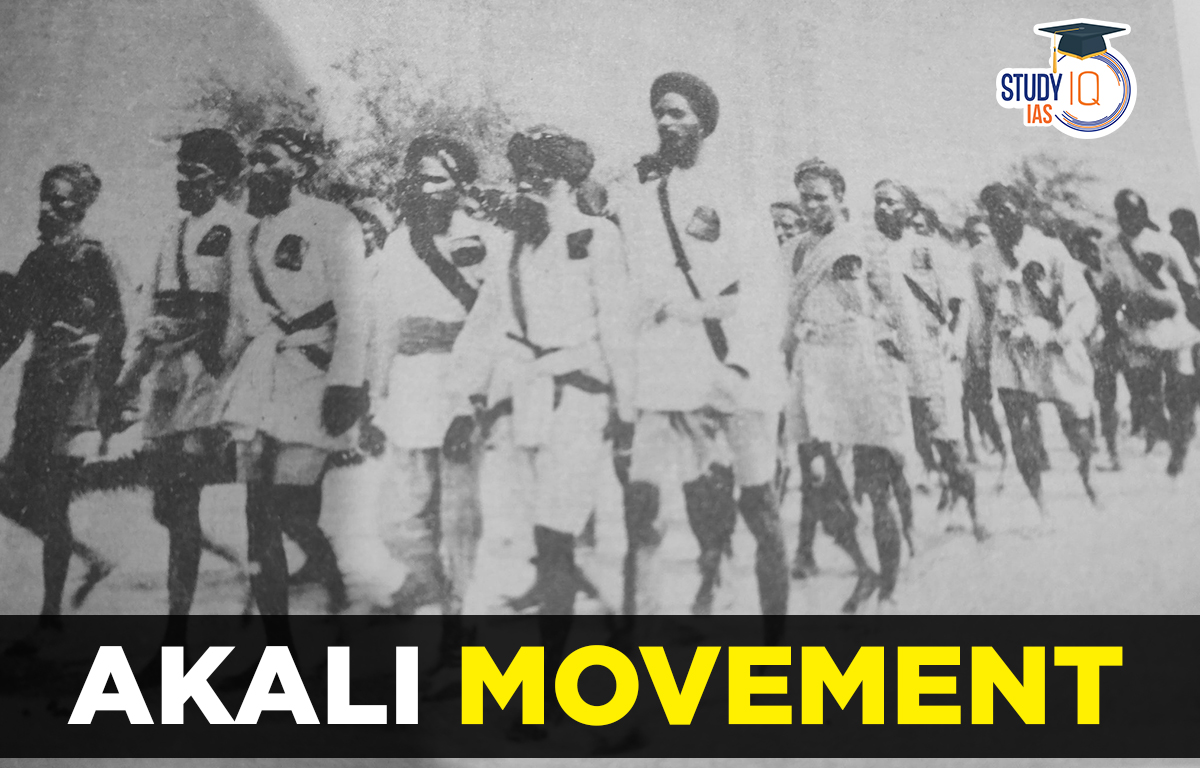Table of Contents
Akali Movement
The 1920s Akali movement, which started out as a purely religious effort to reform Gurdwaras, or Sikh sacred temples, gradually acquired a political bent and was a crucial element in India’s campaign for independence. The Akali movement, often referred to as the Gurdwara Reform Movement or Gurdwara agitations, portrays the Sikhs’ protracted struggle for the liberation of their Gurudwara, or holy temple, in the early twentieth century. It is also anti-imperialist.
Marches for nonviolent agitation, divans or religious gatherings, and demonstrations in support of Sikhs’ right to manage their place of worship attracted enthusiastic support, especially from rural residents. The Gurdwara Act of 1925, which established the Shiromani Gurdwara Parbandhak Committee (SGPC) to serve as custodian of all prominent Sikh places of worship, was the government’s response to public clamour to empower Sikhs to manage their shrines. You will learn about the Akali Movement in this article, which will help with your preparation for the UPSC Civil Service Exam in Modern Indian History.
Read about: Civil Disobedience Movement
Akali Movement History
Sikh reformers established the Akali Movement to purify their sacred sites by eradicating the harmful social customs that had progressively crept into them. The Sikh Gurus built the Gurdwaras or Dharamsala to serve as places of worship, educational institutions for social and moral development, and shelter and food distribution for the underprivileged. Here, the global equality preached by the Sikhs was put into effect. Everyone was welcome to attend these venues and enjoy the complimentary lunch provided in the Langar(Community Kitchen), regardless of caste, colour, or gender.
The Gurdwara administrators, in keeping with the Sikh tradition of piety, did not view the contributions as their own income but rather used them to fund free community dinners and other social welfare initiatives.
Control of the Sikh Gurdwaras went to the Udasis, or those who professed Sikhism but did not closely adhere to its external symbols and thus spared persecution, during the Sikh persecution that followed the death of the tenth Sikh Guru, Guru Gobind Singh. By keeping the Gurdwaras open, the Udasis in charge of the numerous Gurdwaras during the period rendered an important service to the Sikh religion. The majority of them wandered from place to place and was not tied to any particular temple or its riches and property. However, some created legitimate institutions and welcomed adherents, earning the name Mahants.
These Mahants enjoyed the respect and trust of their congregations in the beginning. They also heeded Guru Nanak’s counsel to refrain from desiring the contributions. However, due to the growth in their riches from the revenue-free jagirs bestowed by Maharaja Ranjit Singh and other Sikh kings on the majority of the old shrines, the majority of Mahants abandoned this legacy of simplicity and piety. Mahants committed a number of sinful acts, including as robbing people of their gifts and other possessions. These places’ holiness was destroyed.
Read More: Temple Entry Movement
Akali Movement Objectives
The aim of the Akali movement was to curtail, if not totally abolish, the clergy’s hold over Gurudwaras. The Shiromani Gurdwara Parbandhak Committee was given authority over all historically significant Sikh sites in India by the Sikh Gurdwara Bill, which was first enacted in 1925. The Akali movement participated in the fight for Indian independence and backed Gandhi’s non-cooperation movement.
The mediaeval Gurdwaras of the Sikhs were under the jurisdiction of these Mahants, who had the support of the British Empire. The Akali Movement was established to free them. Sikhs had to make the ultimate sacrifices and undergo unimaginable atrocities in order to liberate historic Gurdwaras like Tarn Taran, Nanakana Sahib, and Guru-Ka-Bagh. Furthermore, Gurdwara Rakab Ganj, Darbar Sahib, Amritsar, and Gurdwara Jaito management and religious freedom had to be fought for by Sikhs against the government.
Read More: Reform Movements in Southern India
Akali Movement Factor Responsible
1. Misuse of Shrine Funds
Sikh religion underwent a substantial alteration as a result of the ascendance of strong Sikh chiefs in the late eighteenth century and Ranjit Singh’s founding of a state in 1799 A.D. Rich and powerful Mahants also emerged as a result of the property and privileges associated with holy locations, which led to the establishment of intricate rites and rituals.
Nearly all of the well-known Gurdwaras were gifted with sizable tax-free jagirs by Maharaja Ranjit Singh and later Sikh Chiefs. The Mahants of certain significant Gurdwaras changed their way of life as a result of the rapid increase in revenue. They started converting the trust assets of the Gurdwara into their own belongings. This was a blatant violation of the prohibitions imposed by Sikh Gurus and Sikh texts.
The Mahants and their adherents gradually started to live in luxury and partake in numerous social vices. In addition to organising a movement to free Sikh shrines from the hereditary Mahants’ domination, supporters of Sikhism attempted to put an end to these Mahants’ terrible acts through social protest. This reform movement is referred to as the “Akali movement” because of the Akali Juthas, who led it.
2. Gurudwara Problem
The Gurudwaras were under the mahants’ corrupt rule. They led opulent lives and treated donations to the temple like their own personal property. Following the British occupation of Punjab, government-appointed managers who cooperated with the mahants exercised some control over the region. These mahants received support from the British administration and instructions to keep Sikhs away from the national movement.
The Gurudwaras were under the mahants’ corrupt rule. They led opulent lives and treated donations to the temple like their own personal property. Following the British occupation of Punjab, government-appointed managers who cooperated with the mahants exercised some control over the region. These mahants received support from the British administration and instructions to keep Sikhs away from the national movement.
The gurudwara in Nankana served as the true test, though. The peaceful Akali adherents’ deaths were brought on by the mahants, who had gathered a mercenary army. The administration observed how the national movement and the Akali movement were melding together more and more. It passed legislation granting akalis control over gurudwaras to pacify the moderates, but it employed force to suppress the radical akalis.
Read More: Self-Respect Movement
Akali Movement UPSC
During this movement, the Sikhs shown tremendous composure and bravery in the face of the cruelty and murder committed upon them by the British Government and the Mahants, who received assistance from the British. The Gurdwara Reform Act, which was passed in July 1925, placed Panthic rule over all Gurdwaras in Punjab. Elected Panthic organisations, such as the Shiromani Gurudwara Prabandhak Committee and neighbourhood Gurdwara Committees, were to exercise this authority. As a result, depraved aspects and behaviours were eliminated from sacred sites, and the money raised was put to good use by the community for the spread of the Sikh faith. Read all about Akali Movement in this article for UPSC Exam Preparations.
Read More: Reform Movements in Southern India


 Birsa Munda Birth Anniversary 2025: Life...
Birsa Munda Birth Anniversary 2025: Life...
 Military Innovations of Afghans and Turk...
Military Innovations of Afghans and Turk...
 Self-Respect Movement, History, Objectiv...
Self-Respect Movement, History, Objectiv...

























